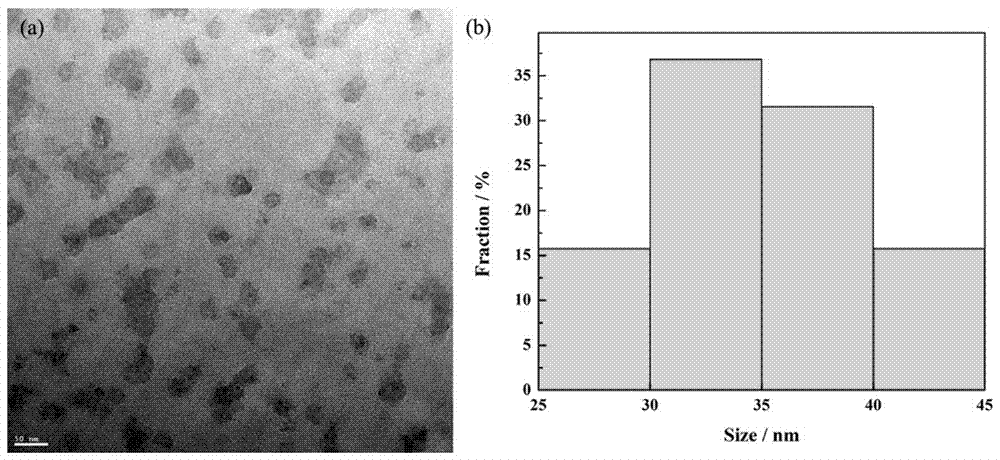Light-driven nano-antibacterial agent and preparation method thereof
A nano-antibacterial, light-driven technology, applied in the fields of botanical equipment and methods, fungicides, nanotechnology, etc., can solve the problems of large band gap, easy recombination of photogenerated electron-hole pairs, and restricted application scope, etc. Achieve strong drug resistance and good antibacterial effect
- Summary
- Abstract
- Description
- Claims
- Application Information
AI Technical Summary
Problems solved by technology
Method used
Image
Examples
preparation example Construction
[0027] The preparation method of light-driven type nano antibacterial agent that the present invention relates to comprises the following steps:
[0028] Step 1: Weigh 3-6g of citric acid into a three-neck flask, heat to 200°C and react for 20-50min to obtain an orange solid;
[0029] Next, slowly add NaOH aqueous solution under stirring state, the amount of NaOH added is 1g, after ultrasonic treatment until the solid solution is completely dissolved, gradually add HCl aqueous solution to adjust the pH of the solution to 7; the mass volume fraction of NaOH aqueous solution is 10-40 mg / mL ; The molar volume fraction of HCl aqueous solution is 2-4mol / L;
[0030] Finally, the resulting liquid was dialyzed in ultrapure water for 1 day to obtain a graphene quantum dot (GQD) solution.
[0031] Step 2: After drying the graphene quantum dot solution obtained in step 1, weigh 0.05 to 0.3 g of graphene quantum dots and add them to diethylene glycol for ultrasonic treatment for 20 to 60...
Embodiment 1
[0037] Step 1: Weigh 4g of citric acid into a three-necked flask, heat to 200°C for a certain period of time to obtain an orange solid; then, slowly add 100mL of 10 mg / mL NaOH aqueous solution under stirring, and ultrasonicate for a period of time until the solid solution is completely dissolved Finally, gradually add 2 mol / L HCl dropwise to adjust the pH of the solution to 7; finally, dialyze the obtained liquid in ultrapure water for 1 day to obtain the GQD solution;
[0038] Step 2: After drying the GQD solution obtained above, weigh 0.1 g of GQD and add it to 120 mL of diethylene glycol for ultrasonic treatment for 30 min; then, transfer it to a three-necked flask with a reflux condenser and an electric stirrer, and slowly add 0.768 g Zinc stearate was reacted at 200°C for 2 hours to obtain a dark brown liquid. After the product was centrifuged and washed 3 times with toluene, it was dialyzed with ultrapure water for 2 days, and the suspended matter was filtered out to obta...
Embodiment 2
[0041] Step 1: Weigh 5g of citric acid into a three-necked flask, heat to 200°C for 35 minutes to react to obtain an orange solid; then, slowly add 50mL of 20 mg / mL NaOH aqueous solution under stirring, and sonicate for 30 minutes until the solid solution is completely dissolved. Gradually add 4 mol / L HCl dropwise to adjust the pH of the solution to 7; finally, dialyze the obtained liquid in ultrapure water for 1 day to obtain the GQD solution;
[0042] Step 2: After drying the GQD solution obtained above, weigh 0.2g of GQD and add it to 200mL diethylene glycol for ultrasonic treatment for 40min; then, transfer it to a three-necked flask with a reflux condenser and an electric stirrer, and slowly add 1.536g Zinc stearate was reacted at 180°C for 2 hours to obtain a dark brown liquid. After the product was centrifuged and washed with toluene for 3 times, it was dialyzed with ultrapure water for 2 days, and the suspended matter was filtered to obtain the nano-antibacterial agent....
PUM
| Property | Measurement | Unit |
|---|---|---|
| size | aaaaa | aaaaa |
| percent by volume | aaaaa | aaaaa |
Abstract
Description
Claims
Application Information
 Login to View More
Login to View More - R&D Engineer
- R&D Manager
- IP Professional
- Industry Leading Data Capabilities
- Powerful AI technology
- Patent DNA Extraction
Browse by: Latest US Patents, China's latest patents, Technical Efficacy Thesaurus, Application Domain, Technology Topic, Popular Technical Reports.
© 2024 PatSnap. All rights reserved.Legal|Privacy policy|Modern Slavery Act Transparency Statement|Sitemap|About US| Contact US: help@patsnap.com









